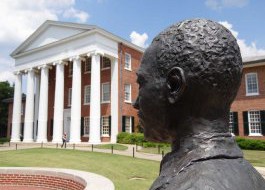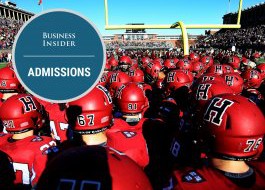
Tuition discounting at private colleges and universities is up again. Tuition revenue is straining to keep up. And enrollment is weak.
Those are the top takeaways from the 2016 Tuition Discounting Study from the National Association of College and University Business Officers. The latest version of the annual study, which was released Monday, provides a look at how much colleges and universities are awarding students in scholarships and grants -- and how much they are effectively undercutting their own tuition and fee sticker prices.
It also offers a glimpse at how such tuition discounts affect other key measures of college and university financial health.
The latest findings show no break from long-established trends of rising tuition discounting. The headline average institutional tuition discount rate for first-time, full-time students hit an estimated 49.1 percent in 2016-17, up from 48 percent the previous year. For all undergraduates, the average institutional tuition discount rate rose to an estimated 44.2 percent, up from 43 percent.
Both rates are all-time highs for the NACUBO study, breaking records set after preliminary estimates came out in last year’s study. The tuition discount rate is defined as institutional grant dollars as a percentage of gross tuition and fee revenue. In other words, a 44.2 percent average institutional discount rate for all undergraduates means that more than 44 cents of every dollar in gross tuition revenue that colleges and universities counted never made it to the bottom line because it was dedicated to financial aid.
 In 2016-17, estimated average net tuition revenue per full-time freshman increased by 0.4 percent. malinawelman/Flickr
In 2016-17, estimated average net tuition revenue per full-time freshman increased by 0.4 percent. malinawelman/Flickr
Two major trends have been driving the increased discounting, according to Ken Redd, NACUBO's director of research and analysis. Students and families have continued to have higher financial needs in the years after the Great Recession than they did before it. And competition for new students is growing as demographic trends point to a declining number of high school graduates in many parts of the country.
“There’s nothing I can see on the horizon that will lower or dissipate those two trends,” Redd said.
The latest Tuition Discounting Study included survey responses from 411 private nonprofit four-year colleges and universities that are NACUBO members. A majority, 318, are small institutions -- defined as colleges and universities mostly conferring associate and bachelor’s degrees and with total enrollment of fewer than 4,000. Another 37 are doctoral-degree-granting research universities, and 56 are comprehensive institutions that grant master’s and doctoral degrees and have enrollment above 4,000 students.
Tuition discount rates were highest among small institutions and lowest for comprehensive universities. The estimated average institutional tuition discount rate for first-time, full-time freshmen at small institutions was 50.9 percent in 2016-17. The rate for all undergraduates at small institutions was 45.1 percent.
At research institutions, the first-time, full-time freshman discount rate was 44.2 percent, while the rate for all undergraduates was 44.1 percent. At comprehensive institutions, the freshman rate was 42 percent and the rate for all undergraduates was 39.2 percent.
Many individual institutions post higher-than-average rates, though.
“About a quarter of institutions have rates well above 50 percent,” Redd said of the freshman discount rate. “So while the average hasn’t crossed 50 percent, a good number of schools have already crossed that point.”
Across all types of institutions surveyed, the percentage of first-time, full-time freshmen receiving institutional grants rose to an estimated 87.9 percent in 2016-17. That was up from 87.2 percent the year before. The average institutional grant for such freshmen rose to be worth 56.3 percent of tuition and fees, up from 55.4 percent.
Meanwhile, 78.5 percent of all undergraduates received institutional grants in 2016-17, up from 78.2 percent the previous year. The average institutional grant for all undergraduates increased to 50.9 percent of tuition and fees, up from 49.9 percent.
Net Tuition and Enrollment Struggles
 Well over half of survey respondents, 57.7 percent, said their institutions experienced a decline in total undergraduate enrollment between the fall of 2013 and the fall of 2016. AP Images
Well over half of survey respondents, 57.7 percent, said their institutions experienced a decline in total undergraduate enrollment between the fall of 2013 and the fall of 2016. AP Images
Increases in tuition discounts haven’t occurred in a vacuum, of course. Colleges and universities raise their sticker prices as well. Yet data in the study indicate that aid to students has risen fast enough to essentially cancel out any effect from higher sticker prices.
In 2016-17, estimated average net tuition revenue per full-time freshman increased by 0.4 percent. That 0.4 percent gain was outpaced by the rate of inflation as measured by the Higher Education Price Index, which was 1.8 percent in the 2016 fiscal year. It was also down from an increase in net tuition revenue per freshman of 1.5 percent the previous year and the lowest rate of increase since 2011-12, when net tuition revenue per student fell by 0.3 percent.
The small institutions discounting the most saw the smallest increase in net tuition revenue per freshman. Small institutions reported an average net tuition revenue increase of just 0.2 percent per freshman in 2016-17. Research institutions reported an average increase of 2.6 percent, and comprehensive institutions reported an average increase of 2.1 percent.
“If you adjust for inflation, many schools are actually seeing real decreases in net tuition revenue,” Redd said. “That’s important, because most private colleges get the bulk of their operating dollars from tuition and fee payments from families. When that number declines, you actually are seeing an indication of some financial stress at these schools.”
Across all undergraduates and all institution types, the average change in net tuition revenue per undergraduate was higher, increasing by 1.5 percent in 2016-17. That’s a larger increase than the year before, when net tuition revenue per undergraduate increased by an average of 0.8 percent. But it was still slightly below the 1.8 percent rate of inflation.
The rise in discount rates did not seem to be enough to bring in additional undergraduates. Well over half of survey respondents, 57.7 percent, said their institutions experienced a decline in total undergraduate enrollment between the fall of 2013 and the fall of 2016. Just over half, 50.2 percent, said they experienced a decrease in enrollment of freshmen. A large portion, 39.1 percent, reported decreases in both total undergraduate and freshman enrollment.
Respondents largely blamed students’ sensitivity to prices, increased competition and changing demographics for losing enrollment. Chief business officers at institutions that had lost first-year enrollment were asked why they believed it fell. The price sensitivity of students was the top response, named by 68 percent of respondents. Increased competition and changing demographics came in next, each being cited by 57 percent of respondents.
A decrease in the number of 18- to 24-year-olds in their region was named by 37 percent of respondents, and 37 percent also pointed to a decrease in yield rate. Only 17 percent of respondents said they lost students because their institution had become more selective, and 8 percent said they lost students because they decreased institutional financial aid. Just 6 percent pointed to a purposeful decision to balance prior-year enrollment results, and 6 percent cited an intentional decision to lower the number of students.
Among respondents at institutions where freshman enrollment grew, most believed it was because of improved recruitment or marketing strategy -- 65 percent. Other reasons frequently cited included an increase in institutional financial aid, named by 48 percent of respondents, and an increase in overall demand for that institution, named by 44 percent. Improved admissions procedures were also named by 44 percent. Just 16 percent of chief business officers said their institutions benefited from changing demographics, and only 2 percent said they decreased selectivity.
Sustainability Questions

Respondents were clearly worried about the sustainability of their tuition discounting strategies. Less than half, 44 percent, said their discounting strategies are sustainable in the long term. Another 32 percent said their strategies are sustainable in the short term but not in the long term, and 20 percent would only say their strategies are sustainable in the short term. Even so, only 9 percent were willing to say their strategies are not sustainable. (Respondents could select multiple answers about their strategies’ sustainability, so the responses do not add up to 100 percent.)
It’s easy to label discounting practices as problematic in the abstract. But for private college leaders trying to build a large enough student body in a competitive environment, it’s a different story. Discounting can be an important tool or a necessity.
“We offer an incredibly generous financial aid package, and someone else increases it by $10,000 or $15,000,” said Kevin F. F. Quigley, president of Marlboro College, in Vermont. “We talk to the students or parents and they say, ‘We love Marlboro, we love what you do there, but they just sweetened the pot by $10,000 or $15,000.’ What can you do about it?”
Marlboro is in many ways an extreme example of the pressures placed on small colleges. It enrolls only 300 undergraduates and 150 graduate students on average. Its undergraduate tuition discount rate is 66 percent.
The college’s discount rate has been pushed up by a recent effort to boost enrollment and academic standing by offering full scholarships to a high-achieving student in every state. The effort helped boost the college’s incoming class from 50 in the fall of 2015 to 71 in 2016. The class entering for 2017 isn’t finalized but will likely be smaller, in the 55- to 60-student range, Quigley said.
The every-state scholarship program required a high amount of investment and effort, such as marketing across the country. With returns diminishing in its second year, it will be revamped for the future. Still, it is an interesting -- if unusual -- case in the discussion about discounting’s sustainability.
“The first year with a new program, a new initiative, the community got really excited,” Quigley said. “But then you move into the second year, and it’s not the new thing. I also think other institutions are discounting to a greater extent, so all of a sudden that’s gone. So, like everybody else, we’re developing a new plan.”
The continued rise in discounting reflects a number of trends, according to Richard Ekman, president of the Council of Independent Colleges. Many students attending college today come from lower-income families than those that attended a generation ago. Many colleges and universities are also making efforts to dedicate aid to such students, so they are able to attend college, he said.
“The other thing to keep in mind for private institutions is that tuition discounting isn’t the whole story,” Ekman said. “Presidents and boards of trustees put such a premium on raising money for scholarships.”
Yet most colleges and universities have not historically been able to rely on funding from endowments for the bulk of the institutional financial aid they offer.
In 2015-16 just 12.4 percent of total institutional grant aid was funded by endowments. It’s a relatively small portion, although it’s up from the year before, when 11.3 percent of institutional grant aid was funded by endowments.
Other Findings
The NACUBO report also wades into the controversial debate about need-based aid versus non-need-based aid. It notes that much of the non-need-based aid -- or merit aid -- that institutions award goes to meet students’ demonstrated financial need.
Need-based aid made up about 41 percent of all undergraduate institutional grant dollars awarded in the fall of 2015, the last year for which data were available. Non-need-based aid used to meet need made up an almost equal share -- 38 percent. Non-need-based aid not used to meet need made up 22 percent.
In other words, 79 percent of aid awarded went to meet need, regardless of whether that aid was classified as need based or merit based.
As more institutions raise sticker prices, the share of students with financial need will likely rise, the report says. Therefore, more students will need aid before they can enroll, and students will care little whether grant dollars are classified as need based or non-need based, it says.
Many would disagree with that assessment, including Stephen Burd, a senior policy analyst with the Education Policy program at New America. Lumping non-need-based aid going to financially needy students with need-based aid is putting a positive spin on the way rising discounting and higher sticker prices affect students, he said in an email.
“It's important to point out that at expensive private colleges, fairly well-to-do students can have some financial need because the prices are so high,” he said. “So just saying that the money is going to students with financial need is a bit misleading. In other words, students who come from families making $100,000 or more a year may show need when attending colleges that have a total yearly cost of attendance of $70,000 (including tuition and room and board, which most four-year private college students pay).”
That echoes a complaint frequently lodged against institutions with high sticker prices and high tuition. Critics argue high tuition enables institutions to say they are meeting calculated financial need for students from middle- and upper-income families when they could instead be dedicating more resources to students from poorer families.
Survey respondents were also asked about the strategies they used in the 2016 fiscal year to increase net tuition revenue. A wide majority, 71 percent, said they used recruitment strategies. Retention strategies and financial aid strategies were also used by large majorities, 69 percent and 63 percent, respectively.
A third of respondents said their institutions changed or added academic programs, and 22 percent said they changed or added facilities. Almost one-fifth, 19 percent, reported using tuition pricing strategies, and 9 percent said they tried no new strategies.
Read the original article on Inside Higher Ed. Copyright 2017. Follow Inside Higher Ed on Twitter.




